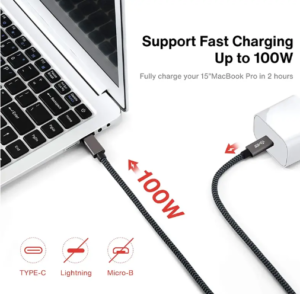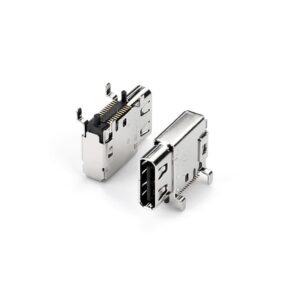
USB4 Cable Specifications: The Future of High-Speed Connectivity
Introduction As technology continues to evolve, the demand for faster, more efficient connectivity solutions has become critical for businesses and
Have you ever wondered what the difference is between usb3 and usb4 connectors? Have you ever wanted to know which connector was better for your phone or tablet? Join us as we look deep into this topic and break it all down with ease.
The USB 4 specification was created by the USB Implementers Forum. They released version 4 of the Universal Serial Bus (USB) standard with many new features such as speed, power requirements, and more. It offers significantly faster transfer speeds than previous USB versions. It can also supply more power than its predecessors as well. This model has only been available since 2017 and desktop computers can now be purchased that use this technology.

USB4 is the latest iteration of the USB standard, and it offers many improvements over older USB connectors. USB4 is based on the new Thunderbolt 3 protocol, which allows for data transfer speeds of up to 40 Gbps. This makes USB4 a great choice for connecting high-performance devices like external hard drives, graphic cards, and docking stations.
The USB4 standard offers a number of improvements over previous versions. Perhaps the most notable is the increased data transfer speed of up to 40 Gbps. This makes USB4 a great choice for connecting high-performance devices like external hard drives, graphic cards, and docking stations.
The USB4 standard also has the USB PD (USB power delivery) feature. This is a specification used for high voltage power supply and fast and efficient charging. With USB PD, USB4 can supply power of up to 100 watts.
Another important feature of USB4 is its ability to connect multiple devices simultaneously. With previous versions of USB, you could only connect one device at a time. With USB4, you can connect multiple devices at once.
USB4 also supports the new Thunderbolt 3 protocol, which allows for daisy-chaining of up to six devices and provides power delivery of up to 100 watts. This means that you can connect multiple devices to a single USB4 port and still have enough power to run them all.
USB4 is easy to identify because it has a blue port. USB3.0, USB3.1, and USB3.2 connectors all have a black port. The blue color of the USB4 has no effect on data transmission speed. It only means the plug is incompatible with older USB ports.
The USB C connector have been standardized in USB4. To identify a USB4, look for the following features:

USB 3.0 is the third major version of the Universal Serial Bus (USB) standard for interfacing computers and electronic devices. USB 3.0 adds a new transfer mode called SuperSpeed or SS, which can transfer data at up to 625 MB/s, over 10 times as fast as the USB 2.0 standard. The maximum throughput of a USB 3.0 connection is about 500 MB/s, while the maximum throughput of a USB 2.0 connection is about 60 MB/s.
USB3 connectors are typically rectangular in shape and have nine pins in three rows. The pins are arranged in a particular pattern so that they can be inserted into the connector housing in one way only. USB3 connectors are also sometimes referred to as “Type-A” connectors.

USB 3.1, released in July 2013, is the successor to USB 3.0. It is the fourth major version of the cabled USB connections for interfacing computers and electronic devices. It increases bandwidth by doubling the speed of all links (universal serial bus) and uses less power. USB 3.1 adds a new transfer mode called SuperSpeed+ or SS+, which can transfer data at up to 1,250 MB/s, over two times as fast as the USB 3.0 standard. The maximum throughput of a USB 3.1 connection is about 1,115 1MB/s, while the maximum throughput of a USB 3.0 connection is about 500 MB/s.
USB 3.1 uses a Type-C connector. This connector is much smaller than the Type-A connectors used in USB 3.0 and earlier versions of USB, and it has a reversible design that allows it to be plugged in either way. The Type-C connector also supports high-speed data transfers, and it can be used to provide power to devices.

USB 3.2 further refines the SuperSpeed transfer mode, which was introduced with USB 3.1 in 2014 and standardized as IEEE Std 1598-2017 by the USB Promoter Group (the group of companies responsible for overseeing the development of the standard), as well as by the International Electrotechnical Commission (IEC) via its joint working group with ISO.
The USB 3.2 connector type is a USB Type-C receptacle. It has a higher throughput than the earlier version of USB, and it is also reversible. The USB 3.2 connector type is also able to transmit power, and this makes it possible to charge devices that are connected to it.
USB3.0, 3.1, and 4 all often cause confusion for people who aren’t familiar with computer technology or hardware components because they all refer to different versions of this common connector type.
USB C is a cable type that fits into the USB C port. Generally speaking, these refer to the physical structure of connectors and ports. On the other hand, USB 4 refers to the functionality and speed of USB cables. The USB C connectors have no backward compatibility but the underlying USB standards (i.e. USB4, USB3, USB2) are backward compatible with older USB devices. It is impossible to connect old USB devices with modern USB-C ports since their physical designs can not fit into each other.
It is essential to find quality USB cables by using reputable manufacturers. Edom Electronics provides high-quality USB4 cables, USB3, USB2, and Thunderbolt4 cables to connect your external devices. They are also open to manufacturing custom requests for your specific needs. Have a chat with their team to find a suitable solution for your USB needs.

Introduction As technology continues to evolve, the demand for faster, more efficient connectivity solutions has become critical for businesses and

Understanding the Evolution of USB Connectors In today’s technology-driven world, USB (Universal Serial Bus) connectors are an integral part of

At EDOM Electronics, we take pride in our meticulous approach to manufacturing high-quality USB C to C cables. Today, we’re
WhatsApp us
